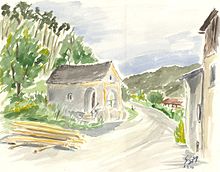Drain mill
The Ablassmühle is a district of the Titting market in the Eichstätt district in the southern Franconian Jura .
location
The mill property is located in the Altmühltal Nature Park , in the Anlauter valley between Titting and Emsing , about 2.5 kilometers from both places.
history
In a book of the city judge and vice cathedral office of Eichstätt from 1548 Seewiesen, called the waste waste, is named as leasable to the Hochstift Eichstätt . Accordingly, the landlord was the Eichstätt prince-bishop. For this, the city judge in Eichstätt took over the taxes of the indulgence mill.
In the 18th century, Leonhard Dirsch (born November 7, 1707 in Emsing; † August 3, 1755 in Emsing), son of Adam Dirsch (* 1663 in Eichstätt; † July 1, 1738 in Emsing), the owner of the Aumühle in Eichstätt who have favourited the indulgence mill in exchange. Since then the mill has been run by the Dirsch family as a prince-bishop's fief; with the secularization of 1806 the mill came into their possession. Later, the company switched from grain milling to sawing.
After secularization and the end of the old empire and thus of the Eichstätt bishopric , the indulgence mill, together with the Herlingshard estate, belonged to the municipality of Emsing in the Middle Franconian district of Hilpoltstein . In the course of the regional reform , the previously independent municipality of Emsing and its districts were dissolved on January 1, 1972 and became part of the larger municipality of Titting and thus on July 1, 1972 to the Upper Bavarian district of Eichstätt .
Today's operation
Today's frame sawmill primarily processes local spruce trees into special pallets and boxes, into products for carpentry, joiner's shops and for the industrial sector, for example for the prefabricated house industry and hall construction.
Monument protection
Of the buildings of the mill are entered in the Bavarian monument list:
- Large half-timbered building with a limestone roof , probably 1st half of the 19th century
- Courtyard chapel , original baroque building, with a cellar, 1832
Burial ground
Near the mill, a burial ground from the late urn field period was cut during road construction in the course of the “Jura development” in 1920 and, due to the route being relocated, further explored in 1982/83 by means of a rescue excavation. In this case were 21 to 23 flat cremations with ceramic vessels and bronze jewelry as grave goods surrounded by flat annular stone settings are exposed.
Others
There are two legends about the indulgence mill that were recorded by the legend collector Emmi Böck .
literature
- Cornelia Schütz: The urnfield time grave field of Titting, Eichstätt district , in: Collective sheet Historischer Verein Eichstätt 83 (1990), pp. 7-11
- Cornelia Schütz-Tillmann: The urnfield time grave field Titting-Ablaßmühle , in: Report of the Bayerische Bodendenkmalpflege 36/37 (1995/96), pp. 7-66
- Emmi Böck: Legends from our homeland , in: Erlingshofen. 25 years of the Heimatverein “Rundeck” , Kipfenberg: Hercynia 1996, p. 43f
- Konrad Kögler: Emsing with drain mill , in: Titting. Contributions to the natural and cultural history of the middle Anlautertal , Kipfenberg: Hercynia 1999, pp. 134–140
Individual evidence
- ^ Wilhelm Volkert (ed.): Handbook of Bavarian offices, communities and courts 1799–1980 . CH Beck, Munich 1983, ISBN 3-406-09669-7 , p. 482 .
Web links
Coordinates: 49 ° 0 ' N , 11 ° 15' E



